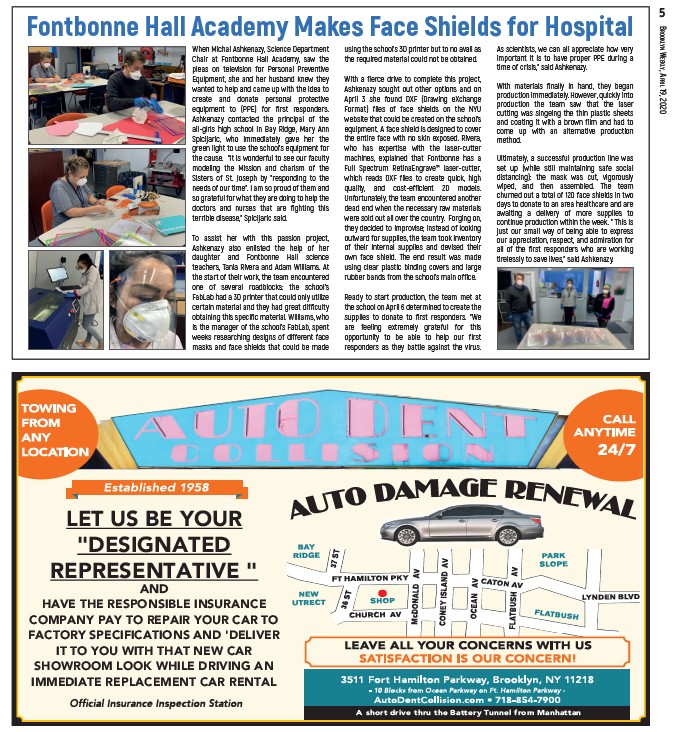
5
BROOKLYN WEEKLY, APRIL 19, 2020
Fontbonne Hall Academy Makes Face Shields for Hospital
When Michal Ashkenazy, Science Department
Chair at Fontbonne Hall Academy, saw the
pleas on television for Personal Preventive
Equipment, she and her husband knew they
wanted to help and came up with the idea to
create and donate personal protective
equipment to (PPE) for first responders.
Ashkenazy contacted the principal of the
all-girls high school in Bay Ridge, Mary Ann
Spicijaric, who immediately gave her the
green light to use the school’s equipment for
the cause. “It is wonderful to see our faculty
modeling the Mission and charism of the
Sisters of St. Joseph by "responding to the
needs of our time". I am so proud of them and
so grateful for what they are doing to help the
doctors and nurses that are fighting this
terrible disease,” Spicijaric said.
To assist her with this passion project,
Ashkenazy also enlisted the help of her
daughter and Fontbonne Hall science
teachers, Tania Rivera and Adam Williams. At
the start of their work, the team encountered
one of several roadblocks: the school’s
FabLab had a 3D printer that could only utilize
certain material and they had great difficulty
obtaining this specific material. Williams, who
is the manager of the school’s FabLab, spent
weeks researching designs of different face
masks and face shields that could be made
using the school’s 3D printer but to no avail as
the required material could not be obtained.
With a fierce drive to complete this project,
Ashkenazy sought out other options and on
April 3 she found DXF (Drawing eXchange
Format) files of face shields on the NYU
website that could be created on the school’s
equipment. A face shield is designed to cover
the entire face with no skin exposed. Rivera,
who has expertise with the laser-cutter
machines, explained that Fontbonne has a
Full Spectrum RetinaEngrave™ laser-cutter,
which reads DXF files to create quick, high
quality, and cost-efficient 2D models.
Unfortunately, the team encountered another
dead end when the necessary raw materials
were sold out all over the country. Forging on,
they decided to improvise; instead of looking
outward for supplies, the team took inventory
of their internal supplies and devised their
own face shield. The end result was made
using clear plastic binding covers and large
rubber bands from the school’s main office.
Ready to start production, the team met at
the school on April 6 determined to create the
supplies to donate to first responders. “We
are feeling extremely grateful for this
opportunity to be able to help our first
responders as they battle against the virus.
As scientists, we can all appreciate how very
important it is to have proper PPE during a
time of crisis,” said Ashkenazy.
With materials finally in hand, they began
production immediately. However, quickly into
production the team saw that the laser
cutting was singeing the thin plastic sheets
and coating it with a brown film and had to
come up with an alternative production
method.
Ultimately, a successful production line was
set up (while still maintaining safe social
distancing): the mask was cut, vigorously
wiped, and then assembled. The team
churned out a total of 120 face shields in two
days to donate to an area healthcare and are
awaiting a delivery of more supplies to
continue production within the week. “ This is
just our small way of being able to express
our appreciation, respect, and admiration for
all of the first responders who are working
tirelessly to save lives,” said Ashkenazy.
LET US BE YOUR
"DESIGNATED
REPRESENTATIVE "
AND
HAVE THE RESPONSIBLE INSURANCE
COMPANY PAY TO REPAIR YOUR CAR TO
FACTORY SPECIFICATIONS AND 'DELIVER
IT TO YOU WITH THAT NEW CAR
SHOWROOM LOOK WHILE DRIVING AN
IMMEDIATE REPLACEMENT CAR RENTAL
A short drive thru the Battery Tunnel from Manhattan